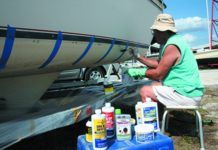Epoxy vs. Vinylester
Several boatyards and resin suppliers have given me strong but conflicting opinions on the subject of applying a two-part waterproofing barrier to a 1981 vintage polyester fiberglass hull. The hull is just showing signs of blistering, and I would like to avoid future problems by applying a barrier coat of resin over the bare gelcoat. A friend and owner of a sistership applied WEST System epoxy resin and claims good results. One reputable yard in South Carolina, familiar with this boat, highly recommended Interprotect epoxy resin for this hull, and the literature available from Interlux and Gougeon Brothers claim each is acceptable as a water barrier on older hulls. However, two reputable repair yards in the Annapolis area claim that epoxy resin should never be used on FRP hulls; only vinylester is acceptable, specifically mentioning Dow and Duratec. Can you shed any light on whos correct?
John A. MacEvoy
Falls Church, Virginia
Before discussing the various resins, let us say that its a good idea to determine the cause of blistering before applying a barrier coat. If there are active compounds in the laminate, such as uncatalyzed resin, this process will continue and the application of epoxy or vinylester resin only seals it in. Therefore, it is recommended that a knowledgeable marine surveyor give an opinion before applying a barrier coat. Unfortunately, the most definitive way to determine the cause of blistering is to have a core sample analyzed in a lab. This gets you involved in a more extensive and expensive job than you probably want, but we must mention it.
As for resins, we tested a number of products in the June 15, 1991 issue and found that vinylester (our sample was from Interplastic-1225 Wolters Blvd., St. Paul, MN 55110) is somewhat superior to epoxy. This corroborated the findings of Everett Pearson at TPI years earlier, which has resulted in many boatbuilders using vinylester resin for the first ply of glass underneath the gelcoat. Other epoxies, including WEST System, also are effective. These are of much thicker viscosity than Interprotect 1000/2000/3000, which goes on more like paint. When we shot blasted the hull of our old C&C 33 test boat down to bare gelcoat, we first coated with WEST, then applied Interprotect over it. The latter goes on with a roller and is quite easy. The boat had no blisters to begin with, so these measures were just for insurance. We guess it was a belts and suspenders response, given that either product by itself would probably have sufficed. It just seemed to us that the thicker WEST System epoxy might be helpful, followed by the Interprotect for extra protection.
Vinylester is generally applied by a professional yard, and is most often done on hulls where the gelcoat has been peeled off. (3M Marine at 3M Center Bldg. 223-6S-06, St. Paul, MN 55144, recently announced a two-part vinylester barrier coat that can be owner applied by brush or roller. A gallon sells for $129.58.) When vinylester is sprayed on it is sometimes mixed with chopped fibers to give it some body. Then it is post cured by elevating temperatures in the room. Epoxy benefits from some post curing, too, but it has a low heat distortion temperature, so you should check with the manufacturer to determine the ideal temperature.
We don’t know why anyone would tell you that epoxy cannot be applied to a polyester hull. This is simply not true. The reverse, however, is true: You wont get a good bond applying polyester to a cured epoxy. Epoxy is recommended for many repairs to polyester hulls because it forms a stronger bond.
For a do-it-yourself job, wed sand the bottom to gelcoat (or pay to have a professional do it with Accustrip baking soda media; see PS April 1, 1994), then, if youre convinced your hull is basically sound, apply the epoxy of your choice. We might instead try the 3M vinylester product, but havent yet tested it. If blisters recur, then youd better hire the surveyor and find out why.




































